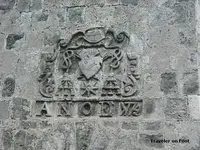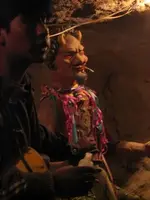Dear desertmoons:
You've asked a very interesting question and when I first arrived in Bolivia I also wondered about the origins of El Tio, just as you do now. In order to explain what I know about El Tio, I will first need to re-cap who El Tio is and where his origins come from, so everyone who reads this topic will be enlightened.
First, El Tio, which literally means The Uncle in English, is a minor religious deity who is *worshipped* by hard rock miners around the Potosi district in Bolivia, however Potosi is by no means the only region is which El Tio is honored. I've discovered that El Tio lives on in all parts of the shaft mining zones of Bolivia as well throughout other regions of South America, mostly notably Peru, Columbia and Brazil. I've also discovered the reason behind this widespread worship and I will explain how El Tio got to be so popular throughout South America in just a moment.
When the South American colonists first started to seriously mine for minerals they soon discovered that native labor was poorly suited for the task at hand and they soon turned to their Portuguese neighbors to barter for African slaves from the Portuguese colonies in Africa. With the arrival of these new workers they brought with them their religious beliefs and customs and since the Africans worshipped multiple deities, it was only natural that they continued doing so in the New World colonies.
From a Christian standpoint, God is represented as living in Heaven which is above us, then the devil would logically live in the fiery hot depths of the Earth. These African slaves held a deep respect for all dieties, both the good and the evil ones, therefore they took to offering small sacrifices to the devil before entering the mine shafts every time they went down to work. It then became commonplace to find small alters carved into niches just inside the openings of practically every mine shaft and it was here that the workers would place small offerings of tobacco, sugar or other such sacrifice in order to appease the deity who lived and reigned in the underworld they were soon to enter.
With the Christianization of the African slaves, they slowly converted the purely pagan worship of El Tio into a semi-Christian form of worship, replete with Christian style prayers and icons, to include cruxifixes, religious icons and statues. Since repeating the name of the devil was traditionally shunned by medieval Christians, the local miners took to calling this spirit El Tio, so as not to offend the Christian missionaries. Eventually El Tio evolved into a very Christian-like representation of the devil as we currently know him, most notably sharp, well chieseled featured, goat-like eyes, small horns protruding from the forehead, etc.
The tradition of worshipping El Tio evolved along the exact same lines as voodoo has in the Carribean islands, where there is also a very large populace of ancestors of African slaves. The custom of worshipping El Tio evolved away from the eyes of the missionaries as the miners kept all references and materials regarding El Tio inside the mine shafts where the missionaries seldom ventured, therefore the worship of El Tio remained relatively unknown to the Catholic clergy for several centuries.
By the time El Tio became known to the outside world, the custom was so well established that it evolved into a tradtional symbol of good luck to offer a small sacrifice to him. In every mine that I've been inside of there is
always at least one small statue of El Tio and EVERYONE offers up a couple of cigarettes or a peso or two (just to be safe

) In fact, the superstition has become so large that many miners will not permit visitors to enter a mineshaft unless they've offered up a token sacrifice in order to appease El Tio. It's all a bunch of superstitious nonsense, but why take unecessary chances?
In short, the Catholic clergy did not know about the existence of El Tio and if they would have known they most certainly would have attempted to halt the pagan worship practices that is associated with him. Today, one can find various small statues of El Tio, either carved in wood or made from clay in the local markets around Potosi, Oruro and La Paz.
Your friend;
LAMAR
Post Scriptum; I've taken the liberty of posting a photo of one of the many statues of El Tio which may be found throughout the mineshafts of the famous Cerro Rico (Rich Mountain) mine in Potosi, Bolivia. Please note that I have been informed that the particular statue in the photo has since been removed from the mine and is now housed in a museum.






 Sounds FRENCH... a church/tower in France in the "old" days; HAND of G*D blessing the HEART of "MAN"
Sounds FRENCH... a church/tower in France in the "old" days; HAND of G*D blessing the HEART of "MAN" 

 ) In fact, the superstition has become so large that many miners will not permit visitors to enter a mineshaft unless they've offered up a token sacrifice in order to appease El Tio. It's all a bunch of superstitious nonsense, but why take unecessary chances?
) In fact, the superstition has become so large that many miners will not permit visitors to enter a mineshaft unless they've offered up a token sacrifice in order to appease El Tio. It's all a bunch of superstitious nonsense, but why take unecessary chances?
